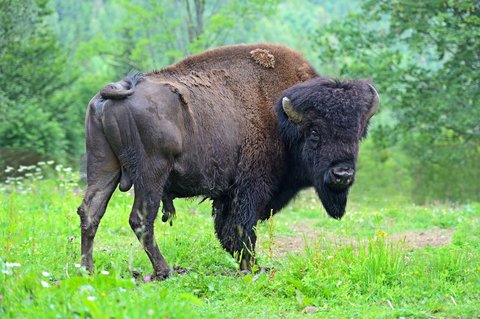Buffalo Bill would be proud. The American Bison – aka buffalo – long a symbol of the American West, has been named the “National Mammal” of the United States.
The U.S. House and Senate recently passed the National Bison Legacy Act, officially commemorating the ecological, cultural, historical and economic contribution of the bison.
RELATED: Stupid Tourists Lead to Bison Calf Death in Yellowstone
As the national mammal, bison will now join the oak (national tree – designated 2004), the rose (national floral emblem – designated 1998) and the bald eagle (national emblem – designated 1782 at the 2nd Continental Congress) as official symbols of America.
The bison, North America’s largest land mammal, has an important role in America’s history, culture and economy. Before being nearly wiped from existence by westward expansion, bison roamed across most of North America. The species is acknowledged as the first American conservation success story, having been brought back from the brink of extinction by a concerted effort of ranchers, conservationists, tribes and politicians to save the species in the early 20th century.
RELATED: Wood Bison Calves in Alaska Promising Sign for Conservation
In 1907, President Teddy Roosevelt and the American Bison Society began shipped 15 animals by train from the Bronx Zoo to Oklahoma’s Wichita Mountains Wildlife Refuge. Many Native American tribes revere bison as a sacred and spiritual symbol of their heritage and are restoring bison herds on tribal lands throughout the West.
Bison now exist in all 50 states in public and private herds, providing recreation opportunities for wildlife viewers in parks, refuges, zoos, and grasslands while sustaining a multi-million dollar sector of American agriculture.
Before being nearly wiped from existence by westward expansion, bison ranged from Alaska to Mexico, from Oregon to New Jersey, and south as far as Georgia. Bison were hunted down to approximately 1,000 at the turn of the 20th century and were brought back from the brink of extinction by a concerted effort of ranchers, conservationists and politicians to save the species.
This early campaign to spare the last few hundred bison evolved into the first major wildlife recovery in world history. The small population secured in states like South Dakota, Montana, and Oklahoma spawned today’s 2,500 privately ranched herds of bison that provide meat, wool and leather to growing markets.
Bison are profiled on U.S. coins, portrayed on two state flags along with several federal and state emblems, and featured on logos of sports teams, businesses and academic institutions nationwide. In addition, bison have been adopted as the state mammal of Wyoming and the state animal of Oklahoma and Kansas.
© Eduard Kyslynskyy | Dreamstime.com – Bison








